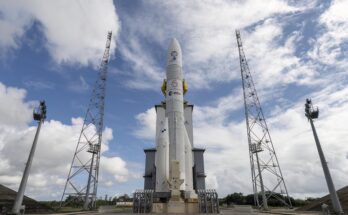by Bill Ostrove, Space Systems Analyst, Forecast International.
Terra Bella is part of a wave of new remote sensing satellite operators that hope to utilize new technologies and business models to break into the Earth imagery business. SkySat satellites have a launch mass of between 100 and 120 kilograms, making them larger than those of some competitors, such as Planet Labs, which is building 6-kilogram satellites. However, SkySats are still smaller than typical commercial remote sensing satellites, like DigitalGlobe’s 2,800-kilogram WorldView-2. Terra Bella expects its satellites to offer a compromise between the two extremes, with better resolution and lifespan than extremely small satellites but higher revisit rates than networks with a few large satellites.
Terra Bella is building a network that will eventually feature 24 satellites each about the size of a mini-fridge. The network will be able to provide global coverage and update images of one spot five to seven times per day with 1-meter-per-pixel resolution. Terra Bella has not revealed prices for its satellites, but they will cost much less than the larger, more complex satellites that are currently favored by commercial remote sensing operators. The small size and weight will also save Terra Bella launch costs.
Large fleets of satellites are enabled by modern computer technology, which allows miniaturization of components. Only a few years ago, small satellites made up only a handful of all satellite launches. In recent years, however, their popularity has grown. Their small size reduces manufacturing and launch costs and improves network resiliency, since the loss of one satellite would not be catastrophic. In the past, most small satellites were built for research institutions and universities to test scientific theories and develop technology. However, companies like Terra Bella and Planet Labs hope to commercialize the new technology.
The biggest boost for Terra Bella came in June 2014 when Google agreed to acquire the company for $500 million (the deal was closed in August 2014). Being part of Google will give Terra Bella enough cash to fund its capital expenditures and keep its satellite fleet up to date. It will also give Terra Bella a ready application, since its satellite imagery will be used to keep Google Maps and Google Earth current. The company will also benefit from Google’s marketing abilities and global reach.
While companies like Planet Labs and Terra Bella offer an innovative approach to remote sensing, their business models are largely unproven. So far, successful operators of remote sensing satellites have relied on large satellites. Furthermore, sales have been largely dominated by government buyers. It remains to be seen if these new companies will be able to sign up enough customers to cover the costs of building a satellite network. Even small satellites can be expensive once launch and insurance costs are included.
That said, Terra Bella’s focus on providing usable and current data to customers, aided by Google’s deep pockets, will drive production of satellites for the foreseeable future. The first handful of SkySat C satellites launched in 2016, all SkySat C series satellites are expected to be in orbit by 2017. There will be additional opportunities for new satellites in the 2020s as Terra Bella replaces aging in-orbit spacecraft and expands operations.
Please feel free to use this content with Forecast International and analyst attributions, along with a link to the article. Contact Ray Peterson at +1 (203) 426-0800 or via email at ray.peterson@forecast1.com for additional analysis.
Forecast International offers two Space Systems Forecast products: Launch Vehicles & Manned Platforms, with reports on manned spacecraft, expendable launch vehicles and more, and Satellites & Spacecraft, with coverage ranging from microsatellites to large COMSATs – all complete with technical specifications and forecast details.
A military history enthusiast, Richard began at Forecast International as editor of the World Weapons Weekly newsletter. As the Internet grew in importance as a research tool, he helped design the company's Forecast Intelligence Center and currently coordinates the EMarket Alert newsletters for clients. Richard also manages social media efforts, including two new blogs: Defense & Security Monitor, covering defense systems and international issues, and Flight Plan, which focuses on commercial aviation and space systems. For over 30 years, Richard has authored the Defense & Aerospace Companies, Volume I (North America) and Volume II (International) services. The two books provide detailed data on major aerospace and defense contractors. He also edits the International Contractors service, a database that tracks all the contractors involved in the programs covered in the FI library. More recently he was appointed Manager, Information Services Group (ISG), a new unit that encompasses developing outbound content for both Forecast International and Military Periscope.




